Just How 3D Laser Scanning Reinvents Architectural Style and Construction Projects
3D laser scanning is changing the landscape of building design and building. This modern technology offers unmatched accuracy in catching existing settings, which facilitates much better task preparation and execution. It decreases mistakes while enhancing effectiveness in numerous stages of advancement. The effects for collaboration amongst designers, designers, and various other stakeholders are significant. These improvements open up the door to brand-new style possibilities and cutting-edge remedies. What lies in advance for this advancing innovation?
The Fundamentals of 3D Laser Scanning Innovation
Although 3D laser scanning modern technology might appear complicated, its core principles are straightforward and transformative for architectural design. This technology utilizes laser light beams to capture specific measurements of physical frameworks, creating a thorough point cloud that stands for the scanned setting. A laser scanner sends out fast pulses of light, gauging the time it takes for the light to return, which enables the computation of distances with exceptional precision.
The resulting factor cloud can be exchanged a 3D design, providing architects with vital visual information. This version makes it possible for experts to manipulate and evaluate layout aspects within their projects, enabling cutting-edge services and boosted visualization. By utilizing 3D laser scanning, architects can better recognize the present problems of a website, guaranteeing that brand-new styles harmonize with their environments. This combination of technology right into architectural layout marks a significant innovation, promoting creative thinking and precision in the area.

Enhancing Accuracy and Efficiency in Architectural Projects
As architectural projects progressively require precision and rate, 3D laser scanning arises as a pivotal device in boosting both accuracy and efficiency. This innovation records countless information points in a brief timeframe, developing comprehensive and accurate 3D versions of existing frameworks. The ability to acquire precise dimensions decreases the danger of errors throughout the design phase, permitting architects to visualize their jobs with unmatched clarity.
The quick information collection process decreases the time spent on-site, allowing teams to concentrate on evaluation and style enhancements. With real-time data availability, changes can be made quickly, promoting a more structured workflow. The integration of 3D laser scanning right into architectural techniques not just enhances measurement precision however also boosts the general project timeline, facilitating quicker decision-making. In a sector where precision is crucial, this technology stands as a transformative pressure, elevating the criteria of building design and building and construction tasks.
Improving Collaboration Amongst Stakeholders
While standard architectural processes usually include fragmented communication amongst stakeholders, 3D laser scanning promotes an extra cohesive collective environment. By giving exact, high-resolution data, this modern technology enables architects, clients, engineers, and specialists to run from a unified point of recommendation. The thorough visualizations generated with laser scanning remove misinterpretations and obscurities, making sure that all events have accessibility to the same info.
This transparency improves decision-making and urges prompt feedback, as stakeholders can easily imagine style components and spatial connections. Additionally, the assimilation of 3D scanning information into Building Information Modeling (BIM) platforms additionally simplifies cooperation, permitting for real-time updates and modifications. Such seamless interaction not just reduces disputes however likewise increases task timelines, as all stakeholders continue to be aligned throughout the design and construction phases. Ultimately, 3D laser scanning transforms conventional process into a more effective and collective procedure, profiting all parties look at this web-site entailed.
Opening Creative Possibilities in Style
By allowing designers to picture complicated spatial connections and detailed details, 3D laser scanning discloses innovative opportunities in layout. This modern technology allows for specific mapping of existing settings, making it possible for engineers to check out innovative principles that could have formerly seemed impractical. With very accurate data, designers can try out unusual forms and materials, pressing the borders of conventional style.
Moreover, the assimilation of 3D laser scanning into the layout procedure promotes partnership among multidisciplinary teams, urging the exchange of ideas and boosting imagination. The thorough visualizations created by this innovation not just help in recognizing potential design challenges but additionally influence services that may not have actually been considered. Therefore, engineers can create a lot more appealing and dynamic rooms that reverberate with customers while meeting useful needs. Ultimately, 3D laser scanning transforms the building landscape, empowering designers to realize their visions with unmatched precision and imagination.
The Future of 3D Laser Scanning in Architecture and Construction
The assimilation of 3D laser scanning right into architectural style not just boosts creative thinking however also establishes the stage for its advancing role in the future of architecture and building and construction. As technology advancements, the precision and efficiency of laser scanning will certainly remain to boost, making it possible for architects and home builders to create more complex designs with precision - 3D Scanning. The use of this innovation in real-time information collection will facilitate much better decision-making, reducing errors and you can check here enhancing operations
Future applications might consist of increased and online fact assimilations, enabling stakeholders to visualize jobs in immersive atmospheres. On top of that, as sustainability becomes a concern, 3D laser scanning will certainly support the growth of energy-efficient layouts by offering thorough insights into existing structures. As collaboration among numerous self-controls becomes more important, the capacity to share precise 3D models will certainly cultivate technology and boost job results. Ultimately, 3D laser scanning will redefine requirements in building design and construction practices.
Regularly Asked Questions
What Is the Price of Executing 3D Laser Scanning Modern Technology?

The length of time Does a Normal 3D Laser Scanning Task Take?
A regular 3D laser scanning job can take anywhere from a couple of hours to a number of days, relying on elements such as the job's dimension, complexity, and the level of detail needed for accurate data capture.
What Kinds of Projects Advantage Many From 3D Laser Scanning?
3D laser scanning benefits various jobs, specifically massive buildings, historical remediations, and complicated improvements. It boosts precision in dimensions, lowers mistakes, and supplies thorough data essential for reliable planning and implementation in building layout and building and construction.

Exist Details Software Application Programs Required for 3D Laser Scans?
Yes, specific software programs are essential for processing 3D laser scans. 3D Scanning. Popular Home Page alternatives consist of Autodesk ReCap, Faro Scene, and Leica Cyclone, each offering special attributes tailored for imagining and analyzing scanned information properly in numerous tasks
Just How Does 3D Laser Scanning Influence Environmental Sustainability in Construction?
3D laser scanning boosts ecological sustainability in building and construction by reducing product waste, making it possible for precise dimensions, and advertising effective resource usage. This modern technology permits much better planning, lowering the eco-friendly impact of construction tasks via enhanced precision and efficiency.
3D laser scanning is changing the landscape of architectural style and building and construction. 3D laser scanning modern technology might appear complicated, its core principles are straightforward and transformative for building style. By enabling architects to imagine intricate spatial partnerships and detailed information, 3D laser scanning exposes creative opportunities in style. The assimilation of 3D laser scanning into the design procedure fosters collaboration amongst multidisciplinary teams, encouraging the exchange of concepts and enhancing imagination. The integration of 3D laser scanning into building style not just improves imagination however also sets the stage for its progressing role in the future of style and building.